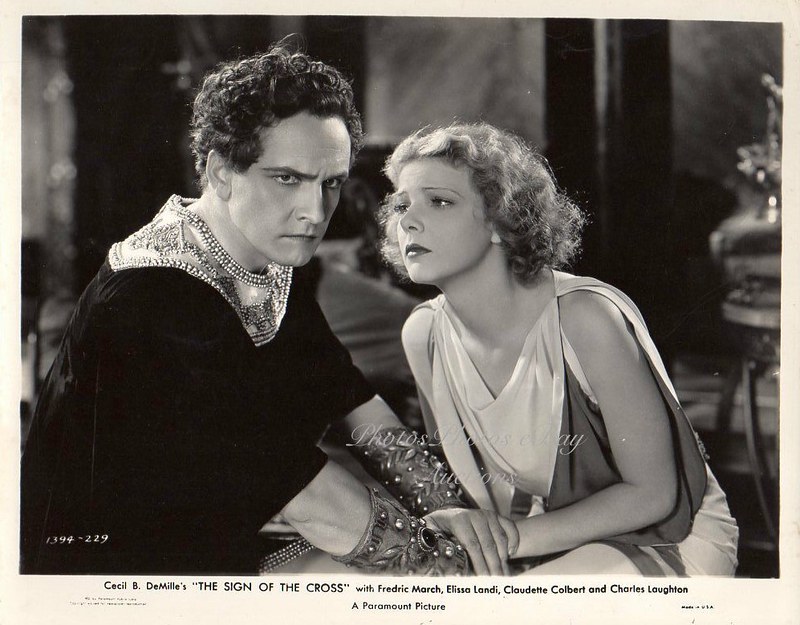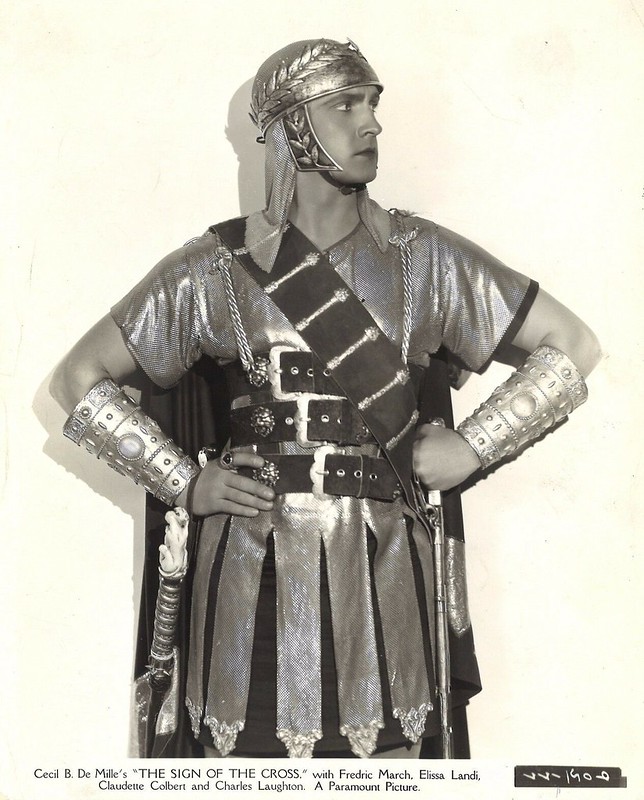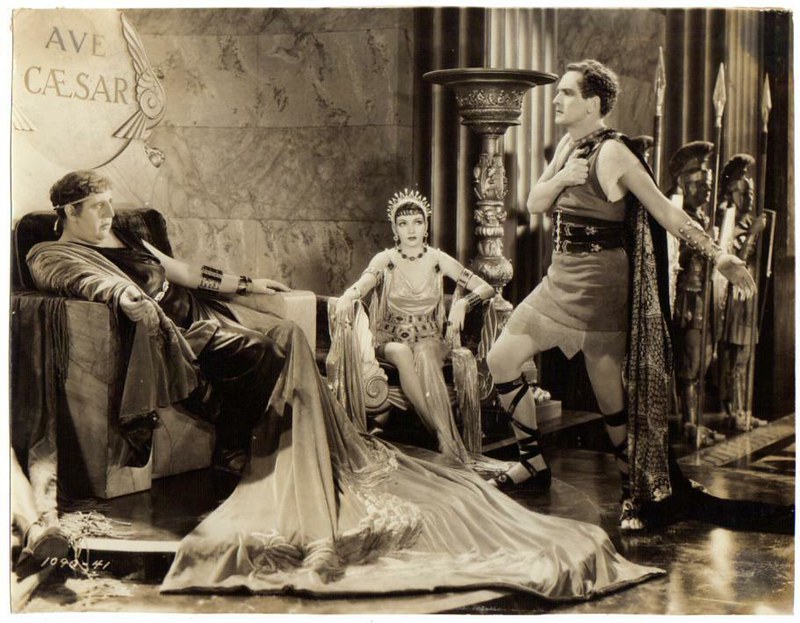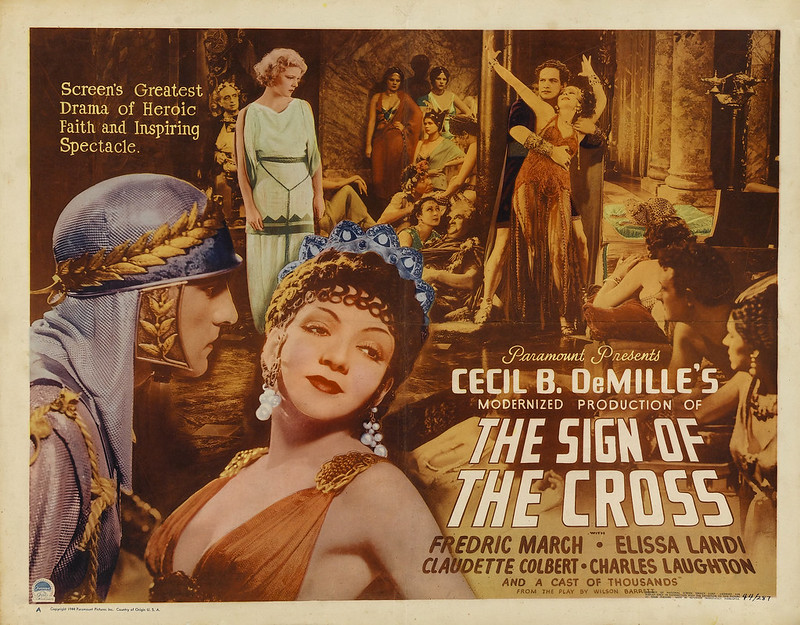“Do you realize the close analogy between conditions today in the United States and in the Roman Empire prior to its fall? Multitudes in Rome were then oppressed by distressing laws, overtaxed and ruled by a chosen few. Unless America returns to the pure ideals of our legendary forebears, it will pass into oblivion as Rome did.” ~Director Cecil B. DeMille, when asked why he would make a film about Ancient Rome with so much unrest in modern America.
August 31 is the birthday of Fredric March, an actor I rank as the finest from Hollywood’s Golden Age. In honor of his birthday today, I wanted to revisit 1932’s The Sign of the Cross— one of Cecil B. DeMille’s most notorious films– in which March had the starring role. It is often cited within the context of pre-Code cinema. However, it was within an entirely different program that I screened The Sign of the Cross; it was part of my 2015 “Films of Faith” series at the Park Ridge Public Library.
The Sign of the Cross has recently been made available on Blu-ray. My copy arrived just this week. Released by Kino Lorber, the Blu-ray features two commentaries, one by author Mark A. Vieira and the other by film historian David Del Valle. This is the restored, uncut version of the film. Shorter versions have circulated for decades. I remember screening a 16mm print of it at the LaSalle Bank Theatre in Chicago. That print was considerably shorter than 126 minutes, as was pointed out by some attendees, but it did have the World War II prologue that had been added for its 1944 reissue.
When discussed today, The Sign of the Cross is almost exclusively analyzed within the context of pre-Code cinema. It’s certainly one of the more shocking examples of “sin on celluloid” made before the Production Code was enforced in 1934. Online reviewers and bloggers, who misrepresent the film as “high camp,” will either fixate on Claudette Colbert’s “milk bath” or the infamous “lesbian dance”– or the violent, arena sequence featuring everything from crocodiles to Pygmies! And, of course, there’s Charles Laughton, who plays the Roman Emperor Nero as a languorous and fey tyrant. Even with all these grand flourishes, The Sign of the Cross offers something more than pure shock value. It emerges as a timeless film about faith. The emotionally-charged final moments remain powerful to this day.
Cecil B. DeMille’s onscreen piety was never fake. He wasn’t selling anything he himself didn’t believe in. Claudette Colbert once said, “He truly believed in what he was doing. When we did the scene with the Christians being eaten by the lions, he really suffered.” But how does one reconcile this with the depictions of orgies and scantily-clad women? Some commentators have misread DeMille, claiming he had a cynical embrace of religion and was more interested in depicting the sins rather than the virtues. In Empire of Dreams, however, author Scott Eyman reveals, “But a thorough examination of DeMille’s papers makes it obvious that he was sincerely, if unconventionally, religious. DeMille committed large portions of the Bible to memory, and assiduously studied primary theological texts.” Richard DeMille, Cecil’s son, said, “He strove to put God’s word on the screen and believed that God approved of his efforts. He believed that Christ had come to save sinners, and he hoped that his sins would be forgiven.”
The excesses that are remembered today are understandable given the fact that DeMille had a lot riding on the film. His last two movies (Madam Satan, The Squaw Man) had been box office failures, and he found himself on shaky ground when he returned to his old studio, Paramount, to make this one. For a man who had put Hollywood on the map and literally formed the studio, it’s ironic that he would be in this position, but that was the scenario he found himself in. In a sense, he was starting over with a new regime and front office.
In need of a hit, DeMille returned to the historical themes he knew best and took as his source an 1895 play, The Sign of the Cross, that had influenced him in his younger days. Religious subjects had been successful for him in the silent era, and they would need to be again for his first epic of the sound period. DeMille partially financed The Sign of the Cross out of his own pocket. Had the film failed, he believed he would be in danger of being washed up in Hollywood– just another relic from the silent era. However, DeMille was determined not to follow the path of the tragic D.W. Griffith.
Fredric March and Elissa Landi in The Sign of the Cross. (From the Matthew C. Hoffman collection)

The Sign of the Cross became part of DeMille’s “divine trilogy.” He had said of his earlier films, as relayed by Mark A. Vieira in the audio commentary, “The Ten Commandments (1923) was the giving of the Law. The King of Kings (1927) was the interpretation of the Law, the fulfillment of its promise. The Sign of the Cross will be the preservation of the Law, the struggle of humanity to live up to it.”
The story is set in 64 A.D., in the days when Emperor Nero of Rome suppressed the emerging Christian faith. The film opens with the burning of Rome– a conflagration that Nero himself had started and which will be used to justify his persecution of Christians. The inferno gives way to a quiet, Roman street where two Christians meet clandestinely– one of whom is an emissary of the apostle Paul. The stranger identifies himself as Titus. (In a DeMille picture, the Christians were usually stoic, wise men with beards and staffs.)
This transitional scene into the streets of Rome stands out because it evokes what cinematographer Karl Struss called “a world remembered.” The film has a unique look that recalls the films of the silent era. “I shot the whole black-and-white picture through bright red gauze,” Struss had said. “Gauze wasn’t much used then, as it had been in the silent period.” The look and texture of the film, as well as its compositions, make The Sign of the Cross one of DeMille’s most beautiful films. It’s a remarkable achievement for Karl Struss, who was nominated for an Academy Award for his cinematography.
Cecil B. DeMille was one of the most cinematic filmmakers of his era. The lighting and camera angles always make his films visually rewarding. In addition to Karl Struss, DeMille benefited greatly from the talents of Mitchell Leisen, his art director who would find great success on his own as a director. Leisen was a sort of jack of all trades for DeMille. Besides the art direction and costumes, he contributed to the opulent set design– no small achievement given the scope of the production and the limitations on time and money.
Additionally, the musical score by Rudolph G. Kopp adds immeasurably by conjuring up the romance of a distant time– building a strong sense of place and adding to the mood and atmosphere of the setting. The score, particularly in these opening moments, does not call attention to itself with blaring trumpets and such. The instruments gently play over the action of the scene like true background music. Kopp would later score DeMille’s Cleopatra (1934).
Titus and the other man, Flavius, are soon captured by Roman spies and become the objects of public scorn. A Christian girl, Mercia (Elissa Landi), comes to the aid of the men, but before mob action can reach a fever pitch, the Roman prefect, Marcus Superbus (Fredric March) arrives in his chariot to intercede. With an obvious admiration (and desire) for Mercia, he allows the two old men to go free. Meanwhile, Empress Poppaea (Claudette Colbert) has her own designs on Marcus.
The film follows Marcus’ courting of Mercia during the planning of a secret meeting by the Christians. Wary of Marcus’ motivations and jealous of his standing with Emperor Nero, Tigellinus (superbly played by Ian Keith) intercedes and has the Christians massacred at the meeting place. Those who survive are sent to prison and ultimately to the arena. Marcus takes Mercia to live with him in his home, but her heart is with those imprisoned. Marcus attempts to kill her soul and later, in desperation, to get her to recant her religion.
Claudette Colbert as Empress Poppaea

Though it is Poppaea (Claudette Colbert) with the role everyone remembers, what is overlooked is the strength of Elissa Landi’s performance. Though less showy than Colbert’s part, Landi is very much the soul of the movie. One of the remarkable scenes in the film is the “Dance of the Naked Moon,” performed by “the wickedest woman in all of Rome,” Ancaria (Joyzelle Joyner). Known as the “lesbian dance,” Ancaria tries to seduce Mercia with her exaggerated gyrations and suggestiveness. Mercia does not break and is made steadfast by the prisoners who sing outside. This strength, however, is perceived as coldness. Without saying a word, Mercia rattles the nerves of the wanton dancer.
Likewise, it is Mercia’s strength that buoys the spirits of the oppressed. When the Christians are in the arena dungeon awaiting execution, she gives them the confidence to face death. Once isolated from them, her cry out to God is heart-breaking.
Though Charles Laughton is well-remembered for his outrageous Nero interpretation (despite appearing in only four scenes), it is Fredric March who carries the film and makes the characterization credible. March, an actor in the John Barrymore tradition, could adapt to any film genre, historical or contemporary. His best moments come when he tries to save Mercia by getting her to renounce her God. The earnestness that March brought to a role was rarely matched in Hollywood.
The Sign of the Cross cost $694,000– slightly over budget– but it grossed $2,900,000. The film saved Paramount from shutting down and it restored Cecil B. DeMille to prominence. In addition, it made a star of Claudette Colbert, who would go on to star in DeMille’s Cleopatra (1934). Today, the film is recognized as one of DeMille’s best films– if not the best. It is a stunning achievement in cinematography, lighting, set design, use of sound, and its memorable performances.
DeMille’s depictions of Christian martyrdom may have been inspired by such paintings as Faithful Unto Death (1888) by Herbert Gustave Schmalz.

“Be faithful unto death, and I will give you the crown of life.” ~Revelation 2:10
Beyond its technical brilliance, The Sign of the Cross is an extraordinary film about keeping the faith in one’s final hours. The film is a tragedy based on historical episodes. The persecution of Christians lasted for 300 years until Emperor Constantine’s Edict of Milan legalized Christianity. Though the particulars may be off– i.e., the Colosseum was built under Emperor Vespasian, not Nero– DeMille was not making a documentary about the early Christians. He was a superb storyteller who brought the past to life in a way no other filmmaker at that time could. There was a reason why DeMille was one of the most commercially successful producer-directors in American cinema. What he showed was that religion could also be good box office.
The Sign of the Cross had a relevance in 1932 that persists to this day. All these years later, in our troubled times, the film’s themes of sacrifice and of maintaining one’s faith in the face of paganism (and its derivatives) still resonate. With the rise of secularism in America, for instance, Christian thought is often marginalized or viewed as out of sync with contemporary societal norms. Religious persecution still exists in the world and faith is continuously tested. The film’s climax can serve as a metaphor for confronting one’s fears and facing the challenges to one’s beliefs.
When I played the film in March 2015, I didn’t rely on the pre-Code aspects to sell it. As a result, only 50 people came out that Thursday night for the library screening. More important than the attendance, though, was how the film affected those viewers. It was rewarding to see one of our patrons, Joe Paolelli, attend because I knew he was a theology student. We both shared an interest in how early Christianity developed and how it has been depicted in movies like The Sign of the Cross, Quo Vadis, and others. The Christians were figures who gave their lives for a belief, and DeMille vividly brought that story to life with great feeling, especially in Titus’ scene with the boy Stephan. Titus speaks to him of having seen Jesus. As Joe elaborated,
“It reminded me of the fact that a subset of the early martyrs actually walked and talked with Christ, and were willing to die for their belief that “Jesus Christ is Lord.” To me, that will always be the most convincing apologetic argument for Christianity. Why would an eclectic group like the Apostles be willing to die for their faith in this man, if he were anything other than who He claimed to be? I found that early scene with Titus and Stephan very moving.”
For more about the making of The Sign of the Cross, here is a link to a terrific entry from www.brightlightsfilm.com. The blog post was adapted from a chapter on DeMille from the new release, Cecil B. DeMille: The Art of the Hollywood Epic (2014) by Mark A. Vieira and Cecilia de Mille Presley.
For a scholarly examination of Cecil B. DeMille and a better understanding of the type of filmmaker he was– and wasn’t– I highly recommend visiting the KINEMA feature: Scripture Filmmaker Cecil B. DeMille: Biblical, Religious or Spiritual?
Finally, The Lost World of DeMille (1993) by John Kobal and Robert Dance is essential reading for anyone interested in the life of Hollywood’s greatest showman.
~MCH


